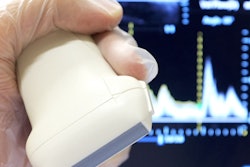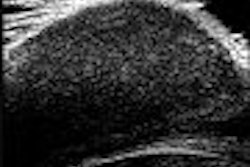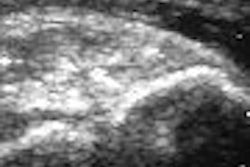Ultrasound vascular screening offers the promise of early disease identification when performed appropriately, allowing individuals to receive preventive medicine, according to Phillip Bendick, Ph.D., of William Beaumont Hospital in Royal Oak, MI.
"Screening is the way to get at these people early before bad things really start to happen," he said in a session at the 2007 Leading Edge in Diagnostic Ultrasound Conference in Atlantic City.
It's important to note that vascular screening isn't for patients, since patients have diagnostic studies based on medical necessity, Bendick said. Instead, screening is performed for asymptomatic "participants."
Nor is screening a diagnostic exam, which may have 30-40 images or more; a standard screening study is typically limited to three to five images, he said. In addition, and probably most importantly, screening is essentially minimal sampling of data. As with any sampled system, screening is subject to diagnostic "aliasing," Bendick said.
"When you don't make enough samples, you may not have a true representation as to what's going on," he said. "The fewer the samples, the greater the aliasing." So screening requires a skilled sonographer, optimal equipment, and knowledgeable interpretation.
Critical elements
Critical elements of screening include the problem of appropriate participant selection, Bendick said. This involves determining who will benefit from vascular screening, weighing variables such as age, risk, and genetic factors.
Participants also need to be educated so that they understand the limited nature of screening and its findings, Bendick said.
"A positive finding of aortic aneurysmal disease doesn't mean you're going to drop dead of a ruptured aneurysm," he said. "But it does mean that there is an aneurysm there, and it does require further diagnostic workup and, possibly, treatment."
Appropriate screening protocols should be developed to ensure that screening examinations and interpretation of results are standardized.
Trained, proficient personnel are critical for successful screening, so it's important to ensure that screening personnel are certified and physician interpreters are trained and experienced, according to Bendick. The ultrasound equipment must also be appropriate, with the duplex ultrasound systems up-to-date and fully capable.
Results must also be appropriately reported, presented in a meaningful way and easily understood, to participants and their primary care physicians, he said.
In addition, ongoing quality assurance is a critical element of screening, ensuring that results are regularly correlated with a diagnostic standard, Bendick said. Screening should also be HIPAA- and regulatory-compliant as well so that participant confidentiality is protected.
Screening should also be highly sensitive, with low diagnostic thresholds for positive findings (such as an aorta ≥ 3 cm, ankle brachial index [ABI] ≤ 0.90, and internal carotid artery [ICA] peak systolic velocity [PSV] ≥ 125 cm/sec), Bendick said.
"You don't want false negatives," he said. "It defeats the purpose of a screening study when you have too many false negatives out there."
Minimal standards
Minimal screening standards for the abdominal aorta include proximal (suprarenal), mid (infrarenal), and distal transverse views, as well as proximal, mid, and distal longitudinal views. Measurement of the anterior-posterior (AP) dimension should be made perpendicular to the walls, from outer wall to outer wall at their maximum diameter, he said.
"That's a very limited version of a complete study of the abdominal aorta," he said.
Peripheral arterial screening should include bilateral brachial systolic pressures, bilateral ankle systolic pressures (both posterior tibia [PT]) and dorsalis pedis [DP]), and appropriate calculation of ABI, Bendick said. Carotid artery screening should include spectral Doppler from proximal ICA, recording of PSV and end-diastolic velocity (EDV), as well as spectral Doppler and grayscale documentation of significant findings.
Screening diagnostic categories should include normal, nonsignificant disease, significant disease, and indeterminate findings. For the aorta, diagnostic categories should include absence of aneurysmal disease, presence of aneurysmal disease, and indeterminate findings, he said.
Peripheral arterial diagnostic categories include normal/absence of disease, presence of disease, nondiagnostic ABI (e.g., calcification), and indeterminate findings, Bendick said. Carotid screening diagnostic categories should include normal, nonsignificant disease (< 50% occlusion), significant disease (> 50% occlusion), and indeterminate findings.
Quality assurance should be performed on a regular basis, with at least 30 correlations every three years, including normal and abnormal findings, he said. The QA findings should also be disseminated to all staff.
Impact
If vascular screening is used to detect the presence of critical disease (such as an abdominal aorta aneurysm [AAA] > 6 cm, ABI < 0.5, or carotid stenosis > 70%), that would be less than 1% of the screened patients. However, if the goal is to identify significant disease (an AAA > 3 cm, ABI < 0.9, or carotid stenosis < 50%), yield could go up to as high as 5%, depending on the patient population.
However, if the threshold is changed to, say, the detection of any vascular disease, yields can significantly increase, according to Bendick.
"If you have good personnel, if you have good state-of-the-art equipment, and you have good physician interpretation of screening results, you're able to do these kinds of things," he said. "It fine tunes the screening a little more, it adds a little more time, but the net gain is you're now talking, if you have appropriately selected participants, a 15% to 20% hit rate."
These are the patients who can be placed into a vascular medicine/preventive medicine program, so risk factors can be aggressively attacked, Bendick said.
"To me, that's going to be one of the terrific, overall emphasis and impact of good-quality vascular screening when you can do something like that," he said.
By Erik L. Ridley
AuntMinnie.com staff writer
September 13, 2007
Related Reading
Screening opportunities boost ultrasound prospects, September 10, 2007
ED physicians can screen for AAA, study finds, May 7, 2007
Abdominal aortic aneurysm screening may reduce mortality in men, April 27, 2007
SVS promotes ultrasound for vascular screening, April 18, 2007
Endovascular repair of acute abdominal aortic aneurysm less costly than surgery, September 4, 2006
Copyright © 2007 AuntMinnie.com




















